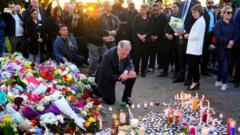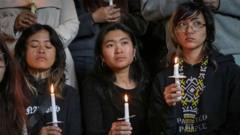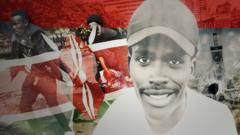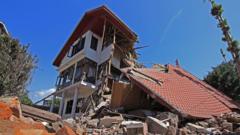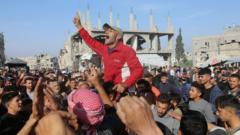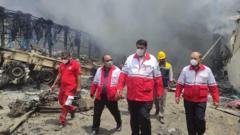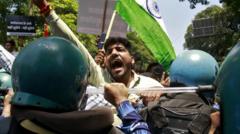A tragic airstrike in Yemen's Saada has raised tensions, killing dozens of migrants and underscoring the complexity of military operations in the region.
Dozens Killed in Yemen Migrant Facility Attack Amid U.S. Airstrikes

Dozens Killed in Yemen Migrant Facility Attack Amid U.S. Airstrikes
Recent strike on migrant center highlights the escalating conflict and humanitarian crisis.
April 28, 2025
In one of the deadliest incidents grimly noted in recent conflicts, dozens of African migrants have lost their lives following a reported attack on a migrant facility in Houthi-dominated northern Yemen. The Iran-backed Houthi militia alleged an American aerial strike targeted the facility in Saada, resulting in the deaths of 68 migrants. As of now, the U.S. military has not confirmed the allegations concerning the attack.
The incident occurred subsequent to an announcement from U.S. forces reporting over 800 airstrikes conducted in Yemen since mid-March, primarily aimed at Houthi military components. These strikes reportedly involved the targeting of command structures, air defense, and weaponry storage sites without acknowledgement of potential civilian casualties. In stark contrast, Houthi officials condemned the incident, describing it as a “heinous crime against African migrants” amidst rising accusations regarding civilian casualties.
According to humanitarian advocates in the area, the airstrike has not only resulted in high fatalities but left at least 40 more migrants injured. As per the International Organization for Migration, an alarming rise of nearly 60,900 African migrants ventured to Yemen in 2024, seeking passage to affluent Gulf nations.
Amidst the backdrop of this tragedy, tensions in the region have intensified following the Houthis' continued missile and drone attacks on targets in Israel and Red Sea shipping lines, citing solidarity with Palestinians under distress in Gaza. U.S. military involvement in the region has spiked post-March 15 under directives from President Trump, promising sustained military efforts until Houthi threats are neutralized.
Ismaeel Naar, an international correspondent for The Times in Dubai, further examines the escalating conflict, reporting on the intersection of human rights and military action in the ongoing crisis.
In one of the deadliest incidents grimly noted in recent conflicts, dozens of African migrants have lost their lives following a reported attack on a migrant facility in Houthi-dominated northern Yemen. The Iran-backed Houthi militia alleged an American aerial strike targeted the facility in Saada, resulting in the deaths of 68 migrants. As of now, the U.S. military has not confirmed the allegations concerning the attack.
The incident occurred subsequent to an announcement from U.S. forces reporting over 800 airstrikes conducted in Yemen since mid-March, primarily aimed at Houthi military components. These strikes reportedly involved the targeting of command structures, air defense, and weaponry storage sites without acknowledgement of potential civilian casualties. In stark contrast, Houthi officials condemned the incident, describing it as a “heinous crime against African migrants” amidst rising accusations regarding civilian casualties.
According to humanitarian advocates in the area, the airstrike has not only resulted in high fatalities but left at least 40 more migrants injured. As per the International Organization for Migration, an alarming rise of nearly 60,900 African migrants ventured to Yemen in 2024, seeking passage to affluent Gulf nations.
Amidst the backdrop of this tragedy, tensions in the region have intensified following the Houthis' continued missile and drone attacks on targets in Israel and Red Sea shipping lines, citing solidarity with Palestinians under distress in Gaza. U.S. military involvement in the region has spiked post-March 15 under directives from President Trump, promising sustained military efforts until Houthi threats are neutralized.
Ismaeel Naar, an international correspondent for The Times in Dubai, further examines the escalating conflict, reporting on the intersection of human rights and military action in the ongoing crisis.

